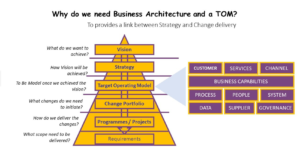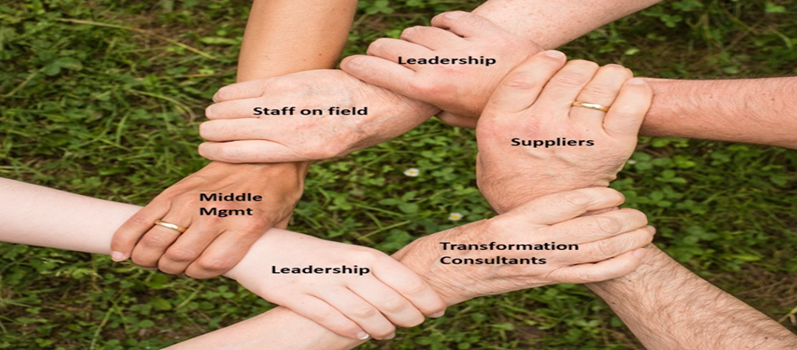Key to a successful Business Transformation
Most Business Transformations takes longer, cost more, and not always deliver the benefits anticipated. Some call it a partial failure and some organisations sadly end up in major transformation failure. Why the majority of efforts fail to reach their intended objectives and what we (as experienced professionals) can do to avoid it? Unfortunately, there is no one magic mantra that fits for all, as every organisation is different, and so is their transformation journey. But there are key practices (mostly related to people) which if followed across the board can potentially lead to a successful transformation; some of them learned by hard experience.
1. Have a clear Vision and well-defined Business strategies on what the Organisation wants to achieve from the Transformation and how it will be achieved.

Organisation must have a clear Vision statement before moving into any major Transformation, stating what exactly it wants to achieve. Vision must be supported by well-aligned Business Strategies suggesting an exact path on how Vision will be achieved. If senior executives are not cautious about selecting the right business strategy, it can end them in a disaster. So make sure Vision and Business Strategy is correctly aligned.

Vision must be concise and convey the message clearly. Once it is defined then make sure everyone in the Organisation is "Communicated" continuously (by all possible communication channels) to be absolutely clear on the Vision and Strategies. People tend to accept Transformation if they understand the purpose, can relate it to themselves and feel they are part of it.

In absence of a clear understanding, everyone tries to interpret and influence it in their own way, leading to confusion on what exactly the company really wants to achieve. Without a clear understanding of the goal, teams who needed to drive success, don't know where to "begin" and "stop".
Take an analogy of a boat being rowed in a different direction by peoples onboarded on it. If everyone influences to move the boat in their direction based on their understanding and interests, the net result is either no movement or movement in the wrong direction where influence is more. By the time Organisation realises it, they have already spent a lot of energy, time, cost in the unknown direction, and need to spend more energy, time, and cost to realign it back.
Seems quite a simple step to define a clear Vision and keep communicating it across the board. But so many times I have seen Organisation fails to communicate adequately, or jump into delivery without even being absolutely clear and convinced what they really want to achieve, going in a spiral, wasting millions before they wakeup. What a waste of time and energy. Strong leadership with a clear Vision can definitely avoid that.
2. Plan it all together

Transformation does not happen in silos. You need to plan it all together. For that, you need to be clear (on a high level) what Product, Services, Channels, and Capabilities you need to rationalise to achieve the Vision and Strategies and figure out all Suppliers / Systems/ Infrastructure/ Assets and Processes required to achieve the Target Operating Model. Of-course you don’t need to deliver all rationalisations in one go but at least you need to plan the prioritisation right and understand all interdependencies to reduce conflicts, redundancies and re-work later.
Many organisations who are still immature in the Business Architecture, don’t know how to assess the organisation As-is maturities and what needs to be done to achieve the Target Business/Operating Model, and so jump straight into series of delivery Program/Portfolios based on the knowledge of handful people. Thus, resulting in an incomplete view and find out gaps down the line, leading to wastage and rework.

Invest in Business Architecture to make an informative decision, especially when the Business Transformation is not just in verticals but horizontal across many Business divisions; to gain efficiency and rationalisation across the board, removing duplications where it needs to be, to gain real benefits. It does not cost much to invest in Business Architecture. So make a small investment for big gains.
3. Hire experienced Transformation Consultants and Empower them

Organisations don't end up in major Transformations on regular basis and so usually don't have the right skills in the organisation to facilitate and deliver major transformations. One needs experienced professionals to manage the Transformation Programs.
Don't hesitate to approach a specialised Big Consultancy (if budget is not a constraint) or independent consultants with proven experience (if you know the art of identifying the right people, with proven industry recommendations).

Worse it can be to hire external consultants but not empower them and let them work under "inexperienced" Organisation staff. Remember if Organisation delivery engagement and governance processes are not matured, not even the best Transformation Consultant in the world can help, unless the Organisation is ready for a major cultural and governance shift and how they do things.
Don't only hire the right professionals but empower them to define the engagement/delivery framework and well defined Team Structure to deliver the Transformation.
4. Promote Culture of Trust and Collaboration

Trust is a basic essence Leaders need to promote between all key stakeholders, to deliver any transformation program successfully and efficiently. Without it, one may manage to deliver the milestones, but not all intended benefits.
Leaders and employees will need to build a powerful sense of mutual trust. So is a need for strong trust between Leadership, Transformation Consultants, and Employees.
If Leaders and Transformation Consultants know the art to gain (& maintain) Trust with people across the board, they can significantly reduce the life cycle of any Transformation program. No more need for excessive governance, protective policies, and unnecessary documentation; results in lesser conflicts, better team collaboration, eventually leading to faster and successful delivery. It’s important to listen, be transparent, and guide all stakeholders to align to a common minimum interest based on budget, time, and priority.

Trust is not easy to gain. It comes over a period of time and one earns it with their acts. Leaders shall have the courage to stand by their words, be ready to accept the mistakes, appreciate and acknowledge others' contributions.
The organisation needs to promote a culture of collaboration and teamwork. It does not matter how intelligent resources you may have assigned in the transformation program but if they are not a team player, they are more an encumbrance than a contributor to any change. Replace them without a doubt. Similarly replace "Bosses" with the Leaders across the organisation, who can engage, lead people by example; at least in key areas.
The culture of Trust alone can reduce the life cycle of any transformation dramatically, beyond imagination, and deliver benefits much swiftly with a longer impact. Can’t emphasise more than that!
5. Deliver iteratively, learn from experience, Identify and celebrates early success

Never ever attempt to deliver all in one go. Always identify early success to achieve Business benefits earlier and start learning from experience to make improvements ahead. Be ruthless in defining the requirement scope priorities aligned with Business Benefits. Come out of Project mindset when its a time to deliver. Need not to say that everyone's focus must be on outcomes, not on the activities.
Understand if things have gone wrong while delivering a part of the transformation, it's never because of a person or team, but because of the immature processes used to deliver the Transformation. Keep the focus on improving the processes rather than pointing fingers at a person or team.

Do celebrate early successes to increase morale. Without celebrating quick wins and experiencing changes in culture that support the vision, people have a very hard time continuing to believe in the mission. So take every opportunity to enjoy the small success, highlighting all changes that have created value for the organisation.
6. Leadership must be committed all along with the Transformation, not just at the beginning and end

When the executive and leadership team is committed, employees and suppliers at all levels better engaged and understand the Transformation, work as a team towards a common goal. Along with commitment, ensure Leadership must be distributed throughout the organization.
Successful transformations must be led by the ecosphere of leaders spread across the entire organization.
7. Transformation is not done to the Organisations but by the Organisation

Transformations are not delivered by one person, one team, or one department. Transformation Consultants are just facilitators. The actual transformation is delivered by the Organisation itself and so efforts must be company-wide. The change leader must make it clear that everyone is accountable for this business-wide transformation.
Always remember that Speed to transform any Business has nothing to do with the efficiency of Transformation Consultants working on the Program. It’s directly dependent on what speed Leadership, Business, & Operations is willing to participate in. Set this fundamental right before thinking of a significant transformation. If you don't have the Business resources to participate in the Transformation, better don't start it until you are ready.
One of the biggest reasons for any transformation program failure is an inability to engage the right stakeholder at the right time. It happens when the Organisation model and structure heavily focused on delivering BAU (Business as usual) activities, and there is no resource time to support the Transformation. Why not design an operating model to have a single point of contact (SPOC) in each Business area to support Business Transformation activities. SPOC shall be the one who is an expert in their area, empowered, have trust from their team members.

Finally, Transformation is not a destination but the start of a new journey. Please don’t end it up without standing an operating model to improve it ahead continuously. Otherwise, the outcome is evident.
Sustaining the change is as essential as the original Transformation itself. So make sure to place the right processes, and process champions who are guardians of change, can proudly represent their business Area, and keep pushing for continuous improvement! Only then you can say at the end….”Welcome to the journey in the future!


About Author:
Ashu Mehta
Founder, Ti3 Consulting
At Ti3, we excel in turning business visions and strategies into effective Target Operating Models (TOM). We go a step further by putting the TOM into action by integrating the right suppliers, systems (whether COTS or Greenfield), processes, data, and infrastructure. We make sure the business vision stays on course as it moves from one team to another. This minimizes deviations, rework, and conflicts during the TOM implementation process.



